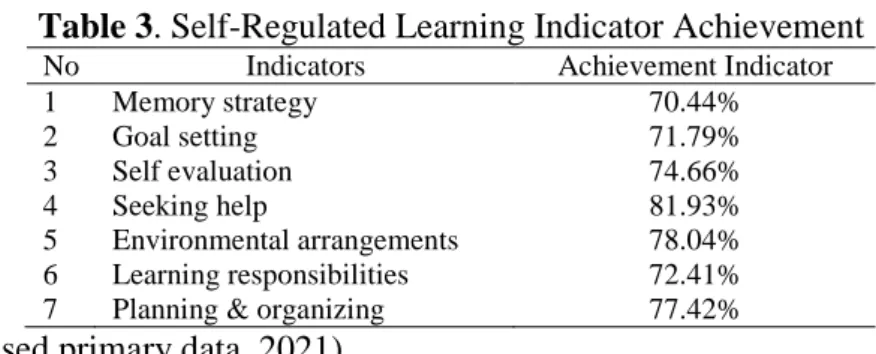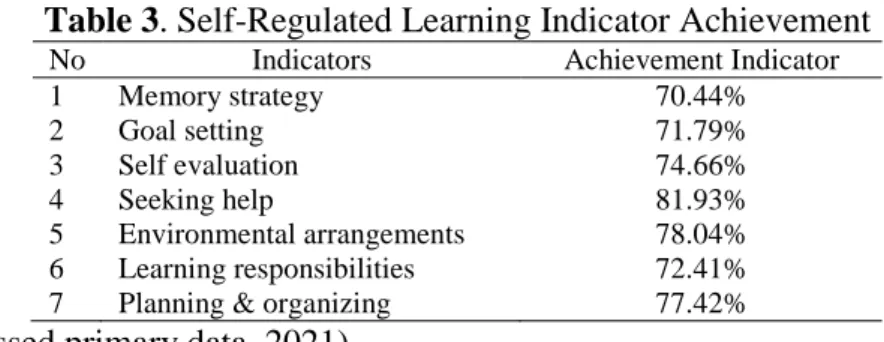To control the situation during the Covid-19 pandemic by using technology and the Internet in accordance with the characteristics of the 4.0 industrial revolution era, one of which is the Internet of Things, which is able to control almost all jobs that can be connected via an internet connection (Risdianto, 2019). According to Risdianto (2019) One of the provisions in the implementation of education during the industrial revolution 4.0 is the existence of connection or access to the Internet network. Correlation test Correlation coefficient test is used to determine the strength of the relationship between the two variables under study.
And Simple Regression This analysis is useful for finding out the direction of the positive or negative relationship between the independent variable and the dependent variable, and for predicting how much change occurs in the value of the dependent variable if the independent variable changes up or down . . This analysis is useful for discovering the direction of the positive or negative relationship between the independent variable and the dependent variable, and for predicting how much change occurs in the value of the dependent variable if the independent variable changes up or down. And Simple Regression This analysis is useful for finding out the direction of the positive or negative relationship between the independent variable and the dependent variable, and for predicting how much change occurs in the value of the dependent variable if the independent variable changes up or down . .
Results Data Description
Test the linearity of this study using SPSS version 23 through the Linearity Test with a significance level of 0.05. 3) To find out the occurrence of inequality variance from one observation residual to another observation in the regression model, it can be done with the help of the heteroscedasticity test (Ghozali, 2016). By looking at the pattern of the scatter diagram, it can be seen that the fulfillment of the heteroscedasticity test criteria, namely if the data points are distributed either above, below or around the number 0, the distribution of the points is not patterned, then there is no heteroscedasticity does not. In testing the hypothesis, two phases are necessary, namely by using a correlation test and simple regression analysis.
In this study, we learned to use the Pearson Product Moment technique, therefore the data was collected in the form of interval data with a Likert scale.
Digital Literacy Variable (X)
Independent Learning Variables
It is known that the maximum value for the self-regulated learning variable is 67, which means that most students give a score of three or four on each indicator. Based on Table 3, it can be seen that the role of each indicator has different influence. Based on these results, it can be concluded that H0 is rejected and H1 is accepted, so that the digital literacy variable has a positive and significant relationship with self-regulated learning during the COVID-19 pandemic for Denpasar University of Hindu Indonesia students.
The regression coefficient is positive, so it can be said that the direction of the influence of the digital literacy variable (X) on the Self-Regulated Learning variable (Y) is positive. From Table 4.9, a significance value of 0.000 <0.05 is obtained, which means that the digital literacy variable (X) has an effect on the self-regulated learning variable (Y). The ttel value is 6.582 > ttable 1.976, so it can be concluded that the digital literacy variable (X) has an effect on the self-regulated learning variable (Y).

Discussion and Conclusion
In other words, digital literacy is a way or form of self-reliance in finding information that is used to achieve self-regulation in learning. In other words, digital literacy is a way or form of self-reliance in finding information that is used to achieve self-regulation in learning. According to Sekarini (2019), digital literacy is one of the efforts that can promote self-regulated learning.
The level of self-regulated learning is also caused by the level of digital literacy that each student has. Next, the digital literacy indicator that has the lowest achievement is cognitive literacy at the 80% level. According to Sekarini (2019) digital literacy is included in environmental factors that can increase self-regulated learning.
This study aims to determine the relationship between digital literacy and self-regulated learning during the Covid-19 pandemic for students at Hindu Indonesia University Denpasar. The results showed that there was a significant positive correlation between digital literacy and independent learning during the pandemic. Research from (Muthupoltotage & . Gardner, 2018) also found a positive correlation between digital literacy and self-regulated learning in connection with technology-based learning.
The aim is to investigate the relationship between digital literacy and self-regulated learning during the student Covid-19 pandemic. The questionnaire used is a closed questionnaire containing statements about digital literacy and self-regulated learning variables. It can be seen that the distribution of digital literacy data with the highest frequency is in the area of the 70-73 and 74-77 interval classes, as many as 35 students.
The results of the hypothesis testing are consistent with the study by Yang & Kim (2014) showing a positive and significant correlation between digital literacy and self-regulated learning in the university e-learning environment. The current pandemic condition shows the real urgency of SRL, one of the important attributes that students must have to achieve self-regulated learning is digital literacy.
JSSER-18-12-22
Minor revision required
Digital Literature and Independent Learning in Covid-19 Pandemic
Correlation Study
Abstract
Keywords: Digital Literacy, Self-Regulated Learning, Covid-19 Pandemic
Introduction
The emergence of online learning as a part of digital literacy can be used as an alternative to the use of technology in teaching, as well as to improve the quality of learning. It is necessary to cultivate Self-Regulated Learning (SRL) to cope with learning difficulties during the current Covid-19 pandemic. It was reported in a news article on Suaramerdeka.com on June 22, 2020, explaining that students do not yet have self-regulated learning, which has become a habit.
Self-regulated learning has several benefits for students, because SRL is a supporter of success in everyday life, including in learning, such as improving academic performance, key to discipline behavior, improving multitasking abilities, increasing rationality in decision-making, increasing efficiency in learn new knowledge (Kristiyani, 2020). Digital literacy is one of the skills that individuals need to have in order to effectively use digital technology to support academic needs, such as when accessing information digitally via the Internet. It is important for every individual to have digital literacy to limit things that can distract students' activities when they access the Internet, so that students' opportunities to achieve learning goals are increased.
According to (Risdianto, 2019), digital literacy aims to improve the ability to digitally read, analyze and use information, in other words, digital literacy encourages the use of digital technology devices to be more efficient and healthy, as today's digital natives, including students, feel less wise if you use the internet to find information. The 2015 agreement of the World Economic Forum requires that all components of society, including students, master six very important basics of literacy, one of which is digital literacy (Umar et al., 2019). Mastery of digital literacy in learning is capable of facilitating and enhancing the learning process and educational outcomes, including SRL student achievement, as students can acquire information in a wider and deeper scope, thereby increasing student insight and helping students complete tasks (Elpira, 2018). ).
Students are also able to survive various obstacles in learning and are able to solve problems faced if they possess digital literacy (Eshet, 2004). The same thing was also said in a news article on the timesindonesia.co.id page on April 10, 2020 that the literacy skills that students have when accessing information from various digital sources is one of the important markers for self-regulated learning. There are several relevant previous studies, such as the results of research by Yang & Kim, (2014) that show a positive and significant correlation between digital literacy and self-regulated learning in university e-learning environments.
Likewise with research results from (Prior et al., 2016) that digital literacy can have a much deeper relationship with Self-Regulated Learning.
Research Methods
It is known that the maximum score for the digital reading variable is 87, which means that most students score three or four in each indicator. Digital Proficiency Level The students' tendency can be classified into three, namely high, medium and low. The digital literacy at Hindu University Siswa Indonesia Denpasar is at a moderate level, which corresponds to 66.22%.
The digital literacy achievement rate for students at Hindu Indonesia University Denpasar is obtained by the results of dividing the aggregated total score by the highest total score, which is 11,068:. This equation can be interpreted as a constant 22,414, meaning that if digital literacy (X) is 0, the amount of self-regulated learning (Y) is 22,414. The results of hypothesis testing using the correlation test show that there is a positive and significant relationship between digital literacy and independent learning during the Covid19 pandemic for students of Hindu Indonesia University Denpasar.
It can be seen from this that the rcount is positive, which means that with greater digital literacy of students, their independent learning will also increase. This is also in line with the results shown in the simple regression analysis, namely the regression value of the digital literacy coefficient (X) of 0.425. Muthupoltotage & Gardner, (2018); Steiner et al. (2013) who concluded that there is a positive and significant relationship between digital literacy and independent learning.
Digital literacy as a form of business that is expressed in the form of the ability to access, browse, analyze and use information digitally. Digital literacy has a positive impact on skills important to support successful student learning (Techataweewan & Prasertsin, 2018). The level of digital literacy and self-regulated learning of Hindu Indonesia University Denpasar students is in the middle category, which means that the students are quite capable of regulating the learning process relevant to the current development of science and technology.
Digital literacy is an important determinant of achieving student SRL because it is facilitated by the availability of technology (Latifah, 2020). Digital literacy has a positive influence on learner skills that are essential for successful learning (Techataweewan & Prasertsin, 2018). Digital literacy should be embedded in the education system because it has a positive influence on student skills that are important for successful learning (Techataweewan & Prasertsin, 2018).








